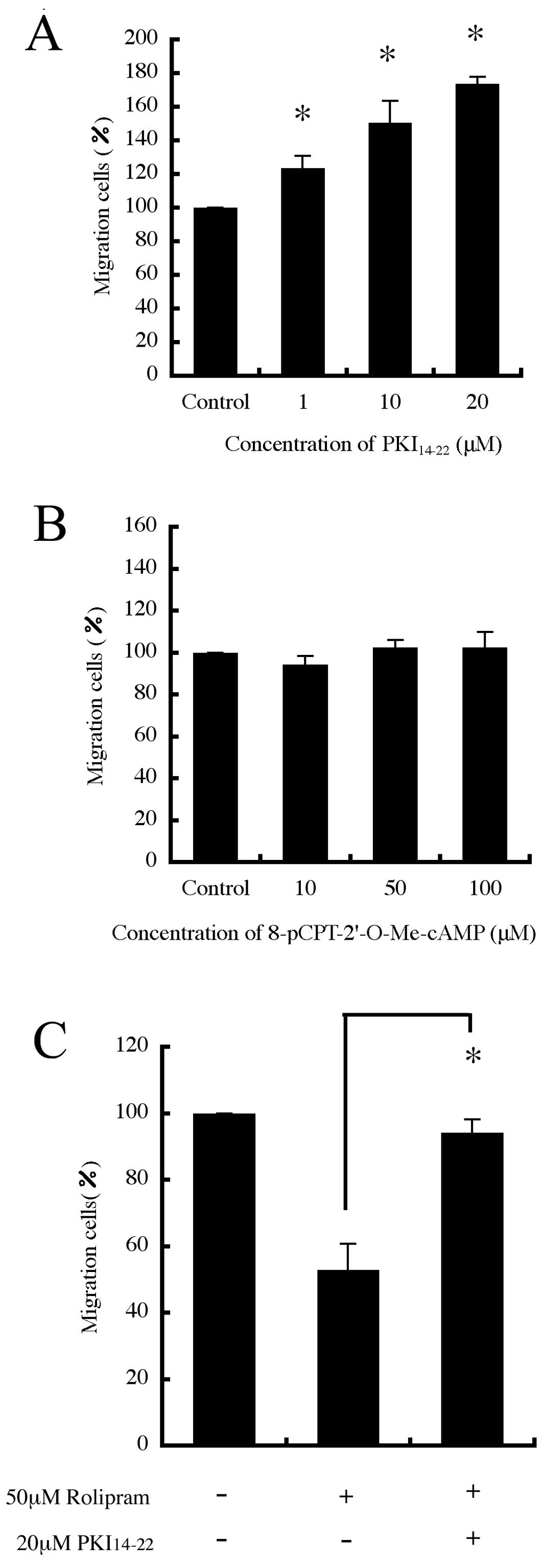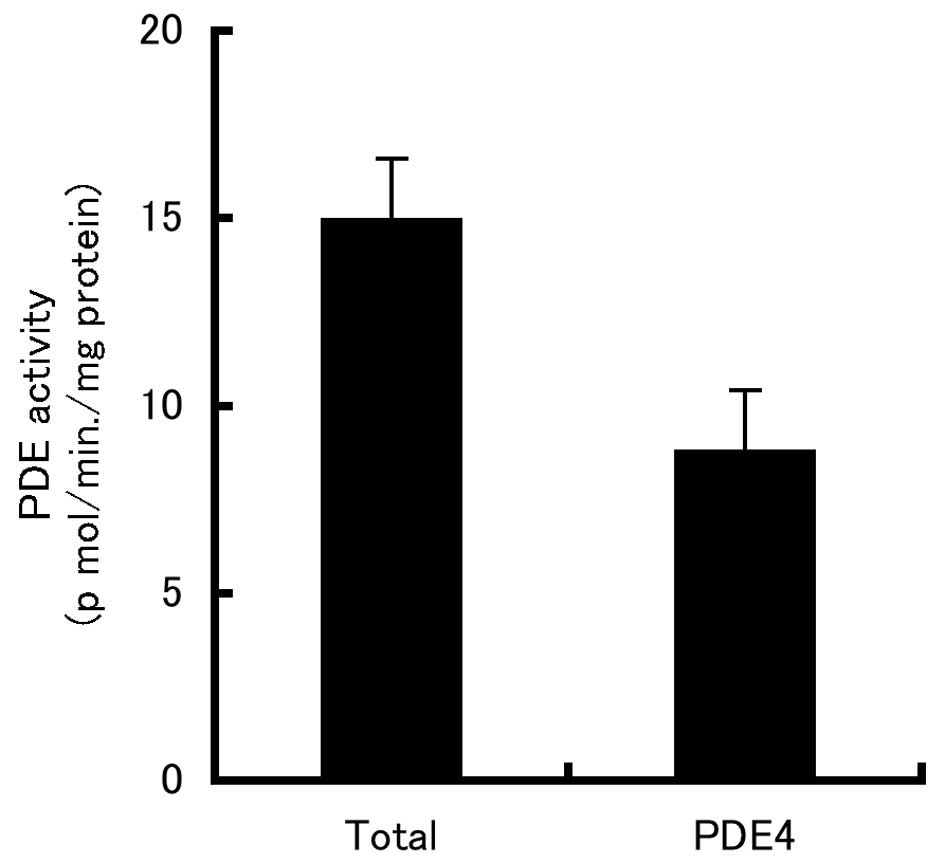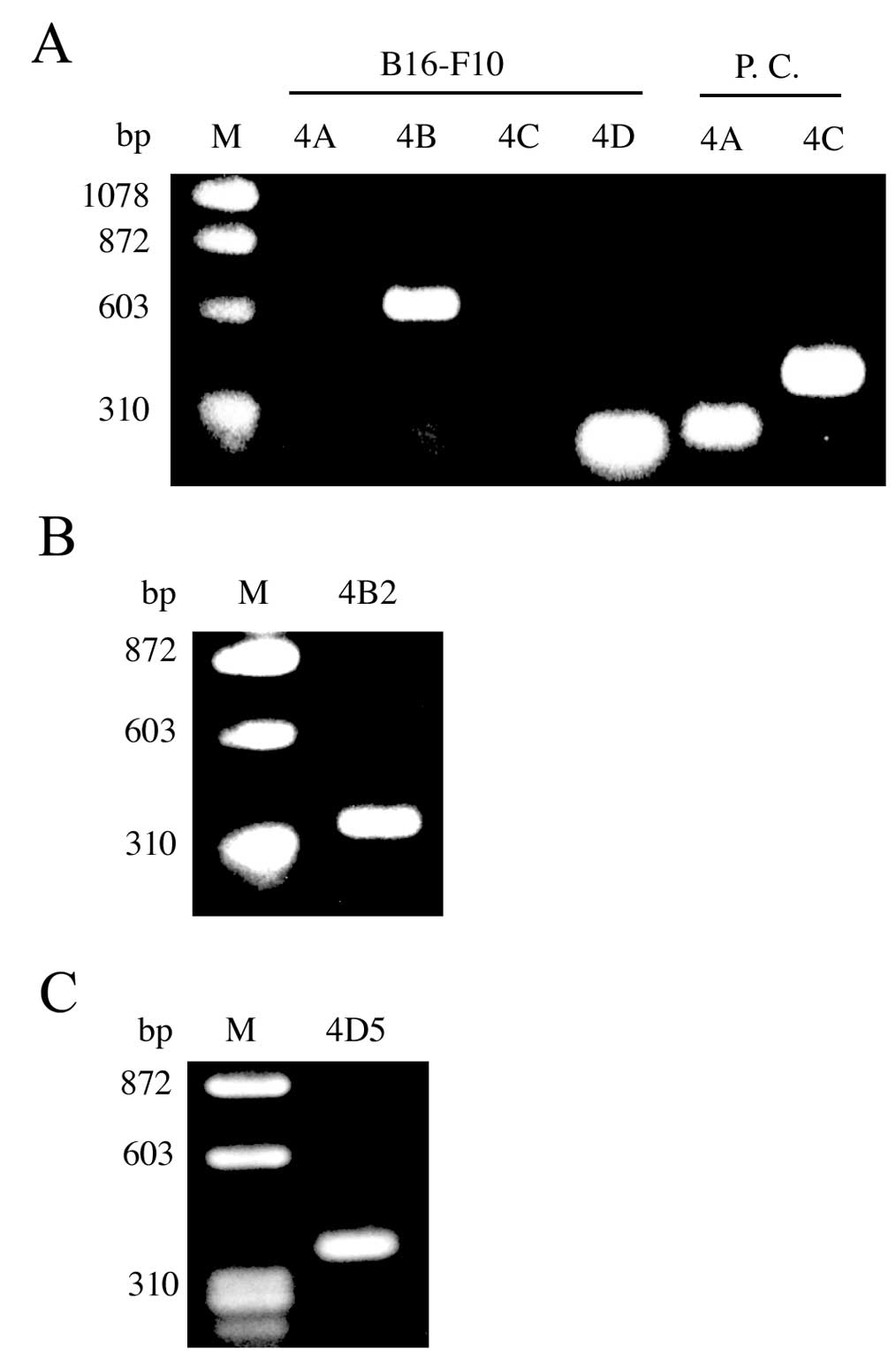Phosphodiesterase 4 regulates the migration of B16-F10 melanoma cells
- Authors:
- Published online on: May 23, 2012 https://doi.org/10.3892/etm.2012.587
- Pages: 205-210
Abstract
Introduction
Melanoma is a major public health problem in many countries. Effective treatment depends upon early diagnosis followed by surgical excision with adequately wide margins. Medical therapies have contributed little to enhancing the control of established metastatic disease (1). Over the past 40 years no drug, or combination of drugs, has shown any impact on the survival of patients with metastatic melanoma; however, molecular pathways have been recently identified that are central to melanoma growth and apoptosis. These pathways are now under intense investigation as potential therapeutic targets (1,2).
The cyclic nucleotide phosphodiesterase (PDE) superfamily represents 11 gene families (PDE1-11) which differ in their biochemical properties, regulation and sensitivity to pharmacological agents. PDEs regulate signal transduction by modulating intracellular levels of cyclic AMP (cAMP) and cGMP. Three of the 11 PDE families (PDE4, PDE7 and PDE8) selectively hydrolyze cAMP, 3 families (PDE5, PDE6 and PDE9) selectively hydrolyze cGMP and 5 families (PDE1, PDE2, PDE3, PDE10 and PDE11) hydrolyze both cyclic nucleotides (3).
PDE4 family members, which exclusively hydrolyze cAMP, are widely expressed and play major regulatory roles. Much of the functional knowledge of PDE4 enzymes was deduced from experiments using highly selective inhibitors, targeted gene knockout, small inhibitory RNA-mediated ablations or dominant-negative mutations to disrupt endogenous intracellular enzyme activities (4). Four genes (PDE4A, PDE4B, PDE4C and PDE4D) encode more than 20 distinct PDE4 isoforms as a result of mRNA splicing and the use of distinct promoters (5,6). The various isoforms encoded by a single gene can differ in their enzymatic properties and tissue distributions. Furthermore, these diverse isoforms each interact with various distinct scaffolding proteins, leading to different roles in compartmentalized intracellular signaling. The PDE4 family has attracted considerable attention over the past decade as its selective inhibitors have potential therapeutic use for a wide range of major disease areas such as asthma, chronic obstructive pulmonary disease, depression and Parkinson’s disease (4).
It is suggested that PDE4 is expressed in several types of malignant tumor cells, where this family may induce apoptosis (7) or regulate cell migration (8). However, the expression patterns and roles of PDE4 in malignant melanoma cells are still unclear. In this study, we examined expression patterns and roles of PDE4 in mouse B16-F10 melanoma cells.
Materials and methods
Cell culture
B16-F10 cells, a highly metastatic lung selected cell subline derived from C57/BL6 murine melanoma, are frequently used for the migration experiments (9). B16-F10 cells (American Type Culture Collection, Manassas, VA, USA) were maintained in Dulbecco’s modified Eagle’s medium (DMEM) containing 10% fetal bovine serum (FBS) (Invitrogen Life Technologies, Carlsbad, CA, USA) at 37°C in a humidified 5% CO2 atmosphere. The medium was changed 3 times/week.
Preparation of cell extracts for cAMP PDE assay
B16-F10 cells were seeded at 2.5x105 cells/25 cm2 flask. After 3 days, the cells were washed twice with phosphate buffered saline (PBS), harvested with a rubber policeman and then homogenized in 1 ml of ice-cold homogenization buffer (100 mM TES, pH 7.4, 10 μg/ml each of pepstatin, leupeptin and aprotinin, 1 mM benzamidine, 0.5 mM Pefabloc, 1 mM EDTA, 0.1 mM EGTA, 5 mM MgSO4 and 10% glycerol).
cAMP PDE assay
cAMP PDE activity was assayed as previously described (10). Samples were incubated at 30°C for 10 min in a total volume of 0.3 ml, containing 50 mM HEPES, pH 7.4, 0.1 mM EGTA, 8.3 mM MgCl2 and 0.1 μM [3H] cAMP (18,000 cpm). PDE4 activity was measured as the cAMP PDE activity inhibited by 10 μM rolipram, a specific inhibitor of PDE4 (11).
RT-PCR
B16-F10 cells were seeded at 2.5x105 cells/25 cm2 flask. After 3 days, total RNA was isolated from B16-F10 cells using the QuickGene RNA cultured cell kit S, and from mouse heart using the QuickGene RNA tissue kit S (Fuji Photo Film Co., Tokyo, Japan). Mouse kidney total RNA was purchased from Stratagene (Santa Clara, CA, USA). First-strand cDNA was generated from total RNA using a High Capacity RNA-to-cDNA™ kit (Applied Biosystems, Foster City, CA, USA). PCR was performed with specific oligonucleotide primer sets for PDE4A, PDE4B, PDE4C, PDE4D, PDE4B2 and PDE4D5 (Table I). The PCR reaction was carried out in a total volume of 50 μl containing 10 mM Tris-HCl (pH 8.3), 50 mM KCl, 1.5 mM MgCl2, 200 μM dNTPs, 2.5 units HotStarTaq™ DNA Polymerase (Qiagen, Hilden, Germany) and 10 μM sense and antisense primers. HotStarTaq™ DNA Polymerase was activated by incubation of the reactions at 95°C for 15 min. For PDE4A, PDE4B, PDE4C, PDE4D and PDE4B2, this activation step was followed by 30 cycles of amplification (94°C for 1 min, 62°C for 1 min and 72°C for 1 min) and 72°C for 10 min. For PDE4D5, this was followed by 30 cycles of amplification (94°C for 30 sec, 60°C for 30 sec and 72°C for 30 sec) and 72°C for 7 min. Products were subjected to electrophoresis on 2% agarose gels and visualized by a SYBR-Green nucleic acid gel stain (Molecular Probes, Inc., Eugene, OR, USA).
Growth experiments
The cells were plated in a 96-well plate (100 cells/well) and allowed to adhere for 24 h. The cells were then cultured in the absence or presence of different concentrations of reagents for 6 days. MTS [3-(4,5-dimethyl-thiazol-2-yl)-5-(3-carboxymethoxyphenyl)-2-(4-sulfophenyl)-2H-tetrazolium, inner salt] assays were performed using a CellTiter 96® Aqueous One Solution cell proliferation assay (Promega, Madison, WI, USA) and cell numbers were calculated.
cAMP concentration in mouse B16-F10 melanoma cells
B16-F10 cells were plated in a 6-well plate (3x105 cells/well). After a 48-h incubation, the cells were incubated with medium containing the indicated concentrations of reagents for 30 min. Intracellular cAMP content was determined using a Cyclic AMP EIA kit (Cayman Chemical Co., Inc., Ann Arbor, MI, USA).
Migration assay
Cell migration was assayed as previously described (12). Briefly, cells (2.5x104 cells in DMEM medium containing 0.1% FBS with the indicated concentrations of reagents) were transferred to 8-μm pore BD Falcon™ cell culture inserts (BD Biosciences, Bedford, MA, USA). The inserts, which were coated with fibronectin (6 μg/membrane) on the lower surface of the membrane, were placed in companion wells containing DMEM medium supplemented with 20% FBS as a chemoattractant. Following a 12-h incubation, the inserts were removed and the cells on the upper surface of the membranes were wiped with a cotton swab. Cells on the lower surface of the membrane were then fixed and stained with Diff-Quick Stain™ (Sysmex Co., Ltd., Kobe, Japan). The cells on the membrane were then counted under a microscope.
Statistical analysis
Differences were statistically analyzed using the Tukey-Kramer multiple comparisons test or Student’s t-test (Fig. 5C). Significance was defined as a calculated P-value <0.05.
Results
PDE4 activity in B16-F10 cells
To test whether PDE4 is expressed in B16-F10 cells, we used the PDE4-specific inhibitor, rolipram. As shown in Fig. 1, ∼60% of the total PDE activity in extracts of B16-F10 cells was PDE4 activity.
PDE4 mRNA expression in B16-F10 cells
To determine which PDE4 isoforms (PDE4A, PDE4B, PDE4C and/or PDE4D) are expressed in B16-F10 cells, we performed RT-PCR. PDE4B and PDE4D, but not PDE4A or PDE4C, mRNA were detected by RT-PCR in total RNA from B16-F10 cells (Fig. 2A). Over 20 different PDE4 isoforms are generated from 4 genes through the use of specific promoters and alternative mRNA splicing. Interestingly, we were able to detect PDE4B2 and PDE4D5 mRNA in the RNA from B16-F10 cells (Fig. 2B and C).
Effect of a cAMP analog and PDE4-specific inhibitors on B16-F10 cell growth
While the cAMP analog, 8-bromo-cAMP (8-Br-cAMP), suppressed cell growth after 6 days of treatment (Fig. 3A), no effects were observed after treatment with the PDE4-specific inhibitors rolipram and denbufylline (Fig. 3B and C). To verify the efficacy of rolipram and denbufylline, we next measured cAMP concentration in the treated cells. After a 30-min treatment, the intracellular cAMP concentration was significantly increased by rolipram and denbufylline at concentrations of 10 and 50 μM for both drugs (Fig. 3D and E). These results confirm that rolipram and denbufylline suppress PDE4s and increase intracellular cAMP concentration.
Effect of a cAMP analog and PDE4-specific inhibitors on B16-F10 cell migration
We next investigated whether PDE4 is necessary for B16-F10 cell migration. We found that 8-Br-cAMP inhibited B16-F10 cell migration (Fig. 4A). Interestingly, the PDE4-specific inhibitors, rolipram and denbufylline inhibited migration in a dose-dependent manner (Fig. 4B and C). It was confirmed that there were no significant changes in the number of cells after having been cultured with each agent (data not shown).
Effect of PKA and Epac on B16-F10 cell migration
Since 8-Br-cAMP activates both protein kinase A (PKA) and Epac (13), we decided to investigate whether targeting these proteins affects cell migration. We first used H-89, a widely used PKA inhibitor, and found that H-89 promoted cell migration in a dose-dependent manner (data not shown). However, H-89 inhibits other protein kinases at concentrations similar to those affecting PKA (14). Therefore, we also studied the effect of a PKA inhibitor, PKI14–22, and found that PKI14–22 also promoted cell migration in a dose-dependent manner (Fig. 5A). In contrast, an Epac activator, 8-pCPT-2′-O-Me-cAMP that only activates Epac without any concomitant activation of PKA on cell migration, had no effect (Fig. 5B). Furthermore, the inhibitory effect of rolipram on cell migration was reversed by PKI14–22 (Fig. 5C). It was confirmed that there were no significant changes in the number of cells after having been cultured with each agent (data not shown).
Discussion
Surgical resection of a malignant melanoma provides an effective first-line therapy; however, melanoma can progress to an aggressive, metastasizing form of the disease with extremely poor patient survival rates (15). Induction of apoptosis by increasing cAMP levels with PDE4 inhibitors has been demonstrated for colon cancer and chronic lymphoid leukemia, suggesting that PDE4 inhibitors, in clinical development for different therapeutic indications, could be a new strategy for cancer treatment (16). Although previous studies report the expression of PDEs in melanoma, their contribution to tumor pathology remains obscure (17). Previous studies have demonstrated that proliferation in B16-F10 cells (a highly metastatic lung selected subline derived from murine melanoma) is suppressed and cell morphology is altered by pentoxifylline, a well-known nonspecific PDE inhibitor with the possible involvement of cAMP-PKA signaling (18). However, the study failed to determine which PDEs were involved. Here, we found that the main cAMP-PDE activity in extracts of B16-F10 cells involved PDE4, and we detected both PDE4B and PDE4D mRNA by RT-PCR. PDE4 isoforms have a role in achieving compartmentalized signaling in cells by interacting with various scaffold proteins. PDE4B and PDE4D have been reported to have distinct patterns of distribution in mouse embryonic fibroblasts and control cAMP in different cellular subdomains (19). These two isoforms might be play different roles in B16-F10 cells. Over 20 different isoforms are generated from 4 genes through the use of specific promoters and alternative mRNA splicing. Recently, Marquette et al (16) reported that PDE4B2 and PDE4D5 are expressed in human melanoma cell lines, whereas mouse melanocytes express only PDE4B2 and not PDE4D. We also detected PDE4B2 and PDE4D5 mRNA in B16-F10 cells. These data suggest that PDE4D5 may be important in malignant melanoma.
Although 8-Br-cAMP suppressed B16-F10 cell proliferation, PDE4 specific inhibitors did not show any effects on proliferation. The PDE4 inhibitors were functional as they yielded an elevated cAMP concentration. Abusnina et al (20), reported that treatment with 10 μM rolipram for 24 h had no effect on B16-F10 cell proliferation, which is consistent with our results. We also tested the effect of rolipram on proliferation for 6 days, but no change was observed. It was suggested that either PDEs may form an enzymatic barrier to cAMP diffusion or, alternatively, compartmentalized PDEs may act as a sink to localized pools of cAMP (19). Therefore, it is probable that other PDEs are involved in proliferation. In B16-F10 cells, in addition to PDE4, PDE8 activity was detected (20) as cAMP-PDE, and by RT-PCR, we detected PDE1A, PDE1B, PDE1C, PDE7A, PDE10A and PDE11A (data not shown).
Notably, PDE4-specific inhibitors suppress B16-F10 cell migration. Recent research demonstrated that RhoA and Rac1 GTPases induce B16-F10 cell motility (21). PKA, which is a major effector of cAMP, induces phosphorylation of RhoA and regulates its function in several cell types (22). It is also reported that PKA-induced phosphorylation of RhoA, as a consequence of PDE4 inhibition, provides a probable mechanism for the reduced RhoA-GTP levels and subsequent effects on peripheral microspike formation noted in rat embryo fibroblast REF52 cells (22). We also found that PKI14–22 promoted cell migration. To investigate whether the inhibitory effect of PDE4 inhibition on B16-F10 motility is mediated by enhanced PKA activation, we also tested the effects of PKI14–22 on rolipram-mediated inhibition of migration. PKI14–22 reversed rolipram-mediated inhibition by almost 100%. Furthermore, we used another effector of cAMP, Epac, which serves as GEFs for the small GTPases Rap1 and Rap2 (22). In contrast to the effects seen with PKA inhibition, 8-pCPT-2′-O-Me-cAMP had no effect on migration. This suggests that PDE4 inhibition suppresses B16-F10 cell migration by inducing downstream PKA activation. Furthermore, Serrels et al (8) showed that PDE4D5 regulates chemically induced squamous cell carcinoma cell polarity. However, in REF 52 cells, it is unclear which PDE4 isoform(s) regulates microspike formation (22). PDE4 isoform(s) that function to regulate cell migration may differ in different cell types. More studies are required to determine which isoform(s), regulate cell migration in a wider panel of cell lines.
In conclusion, our results suggest that PDE4 regulates cell migration via cAMP-PKA signaling in B16-F10 cells and that cAMP-PDE4 signaling may be a new therapeutic target for melanoma.
Acknowledgements
This study was supported by a grant from the Okasan-Kato Foundation to Y. Watanabe and a Grant-in-Aid for Scientific Research (B) from the Japan Society for the Promotion of Science (18390537) to T. Murata.
References
|
Thompson JF, Scolyer RA and Kefford RF: Cutaneous melanoma. Lancet. 36:687–701. 2005. View Article : Google Scholar | |
|
Eggermont AM and Robert C: New drugs in melanoma: it’s a whole new world. Eur J Cancer. 47:2150–2157. 2011. | |
|
Beavo JA, Houslay MD and Francis SH: Cyclic nucleotide phosphodiesterase superfamily. Cyclic Nucleotide Phosphodiesterases In Health and Disease. Beavo JA, Francis SH and Hously MD: CRC Press; New York: pp. 3–17. 2007 | |
|
Hously MD, Schafer P and Zhang KY: Keynote review: phosphodiesterase-4 as a therapeutic target. Drug Discov Today. 10:1503–1519. 2005. View Article : Google Scholar : PubMed/NCBI | |
|
Hously MD: Underpinning compartmentalized cAMP signaling through targeted cAMP breakdown. Trends Biochem Sci. 35:91–100. 2010. View Article : Google Scholar : PubMed/NCBI | |
|
Bolger GB, Conti M and Houslay MD: Cellular function of PDE4 enzymes. Cyclic Nucleotide Phosphodiesterases In Health and Disease. Beavo JA, Francis SH and Hously MD: CRC Press; New York: pp. 99–129. 2007 | |
|
Kim DH and Lerner A: Type 4 cyclic adenosine monophosphate phosphodiesterase as a therapeutic target in chronic lymphocytic leukemia. Blood. 92:2484–2494. 1998.PubMed/NCBI | |
|
Serrels B, Sandilands E, Serrels A, et al: A complex between FAK, RACK1, and PDE4D5 controls spreading initiation and cancer cell polarity. Curr Biol. 20:1086–1092. 2010. View Article : Google Scholar : PubMed/NCBI | |
|
Fidler IJ: Selection of successive tumour lines for metastasis. Nat New Biol. 242:148–149. 1973. View Article : Google Scholar : PubMed/NCBI | |
|
Murata T, Taira M and Manganiello VC: Differential expression of cGMP-inhibited cyclic nucleotide phosphodiesterases in human hepatoma cell lines. FEBS Lett. 390:29–33. 1996. View Article : Google Scholar : PubMed/NCBI | |
|
Houslay MD, Sullivan M and Bolger GB: The multienzyme PDE4 cyclic adenosine monophosphate-specific phosphodiesterase family: intracellular targeting, regulation, and selective inhibition by compounds exerting anti-inflammatory and antidepressant actions. Adv Pharmacol. 44:225–342. 1998. View Article : Google Scholar | |
|
Moutasim KA, Nystrom ML and Thomas GJ: Cell migration and invasion assays. Methods Mol Biol. 731:333–343. 2011. View Article : Google Scholar : PubMed/NCBI | |
|
Holz GG, Chepumy OG and Schwede F: Epac-selective cAMP analogs: new tools with which to evaluate the signal transduction properties of cAMP-regulated guanine nucleotide exchange factors. Cell Signal. 20:10–20. 2008. View Article : Google Scholar : PubMed/NCBI | |
|
Davies SP, Reddy H, Caivano M and Cohen P: Specificity and mechanism of action of some commonly used protein kinase inhibitors. Biochem J. 351:95–105. 2000. View Article : Google Scholar : PubMed/NCBI | |
|
Houslay MD: Hard times for oncogenic BRAF-expressing melanoma cells. Cancer Cell. 19:3–4. 2011. View Article : Google Scholar : PubMed/NCBI | |
|
Marquette A, André J, Bagot M, Bensussan A and Dumaz N: ERK and PDE4 cooperate to induce RAF isoform switching in melanoma. Nat Struct Mol Biol. 18:584–591. 2011. View Article : Google Scholar : PubMed/NCBI | |
|
Lau E and Ronai Z: RAF-isotype switching: from B to C through PDE. Nat Struct Mol Biol. 18:517–518. 2011. View Article : Google Scholar : PubMed/NCBI | |
|
Dua P and Gude RP: Antiproliferative and antiproteolytic activity of pentoxifylline in cultures of B16F10 melanoma cells. Cancer Chemother Pharmacol. 58:195–202. 2006. View Article : Google Scholar : PubMed/NCBI | |
|
Blackman BE, Horner K, Heidmann J, et al: PDE4D and PDE4B function in distinct subcellular compartments in mouse embryonic fibroblasts. J Biol Chem. 286:12590–12601. 2011. View Article : Google Scholar : PubMed/NCBI | |
|
Abusnina A, Keravis T, Yougbare I, Bronner C and Lugnier C: Anti-proliferative effect of curcumin on melanoma cells is mediated by PDE1A inhibition that regulates the epigenetic integrator UHRF1. Mol Nutr Food Res. 55:1677–1689. 2011. View Article : Google Scholar : PubMed/NCBI | |
|
Dua P and Gude RP: Pentoxifylline impedes migration in B16F10 melanoma by modulating Rho GTPase activity and actin organisation. Eur J Cancer. 44:1587–1595. 2008. View Article : Google Scholar : PubMed/NCBI | |
|
Fleming YM, Frame MC and Houslay MD: PDE4-regulated cAMP degradation controls the assembly of integrin-dependent actin adhesion structures and REF52 cell migration. J Cell Sci. 117:2377–2388. 2004. View Article : Google Scholar : PubMed/NCBI |














